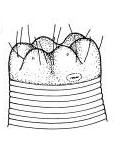 Head of Ablechroiulus
verminosus showing
cephalic setae on lip (from Abolafia and Pena-Santiago, 2009)
Male:
- Reproductive system monorchic. Testis
reflexed ventrad anteriorly.
- Tail with anterior conical part and a very
slender, hair-like, posterior portion 36-44 μm long.
- Cloacal aperture apparently surrounded by five
papillae: one midventral, thick papilla anterior to cloaca and two
pairs of thin, spine-like, papillae, one pair on each ventrolateral
side of cloaca.
- Bursa leptoderan, open anteriorly, with nine
pairs of genital papillae (1 + 2 + 1 + 2 + 1 + 2), papillae 1 and
2-3 widely aseparated (all precloacal), papillae 2 and 3 separate,
papillae 5 and 6 fused at base.
- Spicules fused at terminus: manubrium rounded,
not offset; lamina more or less straight, with velum of
variable development; terminus bifurcate, dorsal branch acute and
short, ventral branch longer, more or less acutely digitate.
- Gubernaculum slightly curved ventrad in posterior
part, with dorsal minute knobs.
Ref: Abolafia and Pena-Santiago, 2009
|
Female:
- Cuticle smooth under LM, but shallow
transverse striation under SEM.
- Lip region continuous with body contour. Lips
rounded with two pairs of setae each.
- Stoma rhabditoid. Cheilostom as long as
wide, gymnostom cylindrical or a truncate cone; stegostom more or
less cylindrical, with glottoid apparatus bearing minute teeth.
- Esophageal procorpus ca three times as long as
wide; metacorpus shorter than procorpus and longer than wide.
Isthmus wide, relatively long. Basal bulb ovoid, with valves at its
midpoint.
- Excretory pore at 76% of neck length, at
isthmus level.
- Cardia conoid, surrounded by intestinal
tissue.
- Rectum 0.9-1.5 times abd.
- Reproductive system didelphic-amphidelphic. Each
ovary with a flexure. Oviduct very short. Uterus tubular, ca two
body diam. long,.
- Vagina extending inwards one-fourth to
one-third of body diam. Vulva prominent.
- Females commonly with numerous hatched juveniles
inside.
- Tail long, filiform. Phasmid located at 13-34% of
tail length.
|